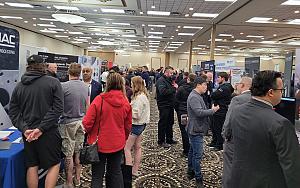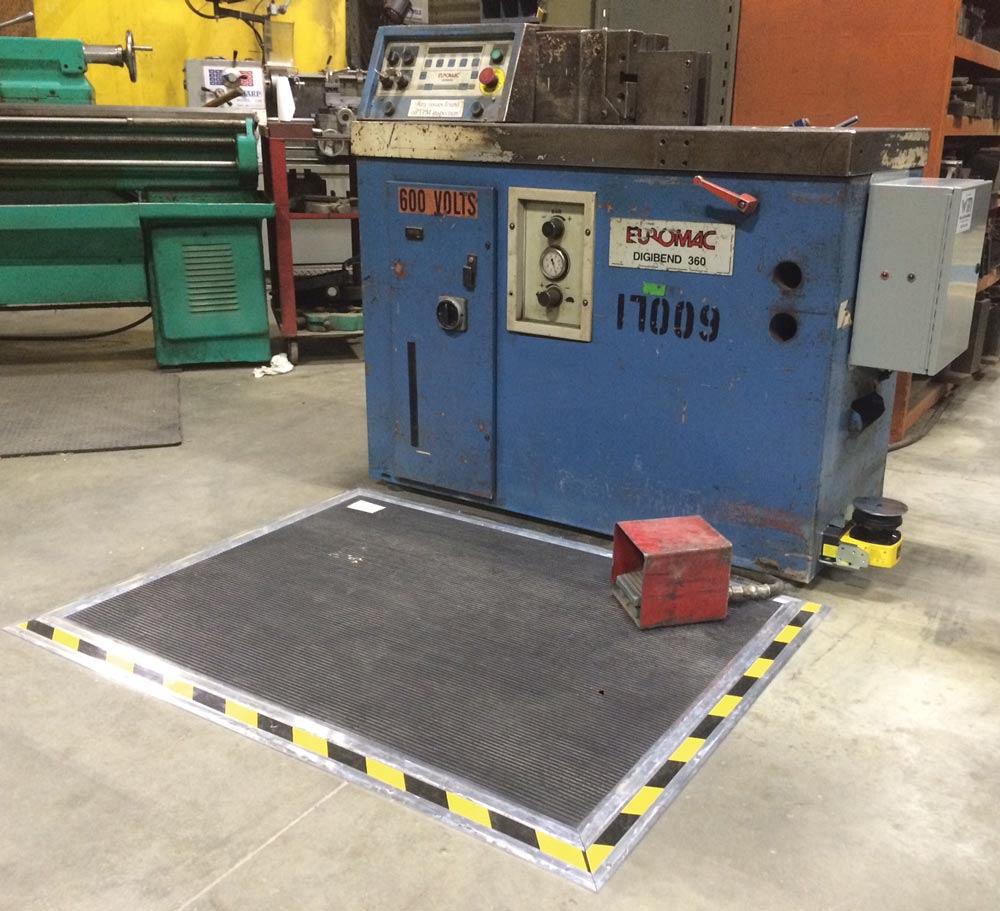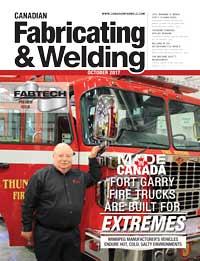- FMA
- The Fabricator
- FABTECH
- Canadian Metalworking
6 things to know about safety
Properly protecting people can be complicated
- By Sue Roberts
- October 26, 2017
- Article
- Management
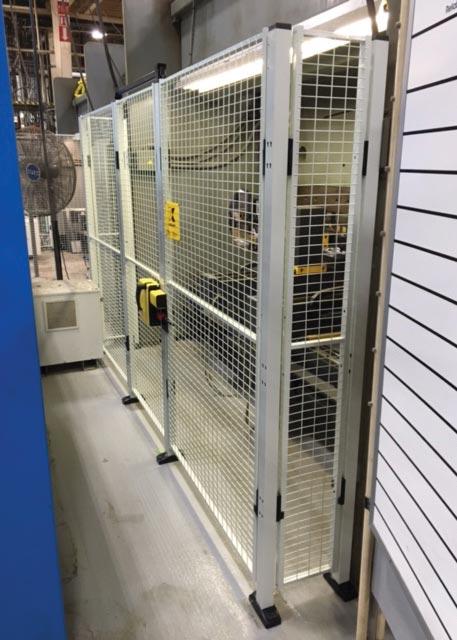
Rear gating and fencing prevent access to danger areas. Special tools allow properly designed gates to be opened to allow machine tool maintenance.
Creating a safe workplace seems like a fairly straightforward concept until an employer looks at the diverse dangers that can arise when operating fabricating equipment, the potential for safety knowledge gaps that can leave operators—and others—vulnerable to injury, and the vast array of safety equipment on the market in innumerable potential combinations. Determining how to provide that safe work environment isn’t always easy and certainly isn’t a one-size-fits-all.
The Canadian Centre for Occupational Health and Safety (CCOHS), which tasks employers with the protection of their employees, readily admits that what is needed to provide safety at one company is different than what is needed at another. Its website says, “It is not possible to develop a standard prevention program that would work for all businesses.”
Help, however, is available. Equipment manufacturers are a good place to start. For example, keep any guards provided with the equipment in place and take advantage of their safety recommendations and training. Safety auditors can be hired to evaluate each piece of equipment on the shop floor. They will identify areas of concern or non-compliance but don’t provide solutions. An auditor may not understand all the ways a particular piece of equipment can be used. For example, a press brake at one company may be used to bend large panels, so hands are not close to the pinch point. The concern there may be supporting the panel. In another company, a similar brake may bend small components that require the operator’s hands to be much closer to the danger zone, so it requires protection.
Then there are safety integrators, who can work with a company to develop safety strategies and then and identify and install equipment based on its specific equipment and processes.
Ryan Heron is the service manager/technician and safety integrator at Wallace Machinery & Tool Co. in Manitoba. His safety integrator distinction began with a project that integrated a safety system on a press brake. “I did the integration on the one machine, word spread, and more customers called and asked for similar assistance. It grew from there.” He provides safety integration services for single pieces of equipment and comprehensive safety plans for entire facilities nationwide.
When servicing a machine, he provides the additional benefit of alerting the owner to any piece of equipment that represents a safety hazard or is not compliant with CSA Group regulations—and he recommends a fix.
Heron shared some of his safety insights and thoughts with Canadian Fabricating & Welding.
1. Safety Is an Investment
“Safety is expensive. It’s an ongoing investment with only one return, and that is the safety of the employees. Nobody buys a piece of safety equipment to make money. A lot of employers want the best for their employees and are increasing their safety focus and investment. They understand that a safe environment is as important to the success of the company as good employees, and that the cost of good safety programs and equipment has a much lower price tag than if there was a government safety inspection that found non-compliant or got involved due to an on-site accident.
“An investment in safety today can save an employee’s finger, hand, or arm. The initial cost of safeguarding that employee will be a lot less than an accident-related lawsuit. And, say an employee loses a finger, the company will be put under the regulatory microscope.
“An example of ongoing safety investment would be a company re-evaluating and adding safety equipment to bring a piece of non-compliant equipment that has run safely for 20 years up to code. Enforcement of the safety code may not have been heavy when the equipment was purchased, but now some regulatory agencies are catching up and identifying these pieces of equipment.”
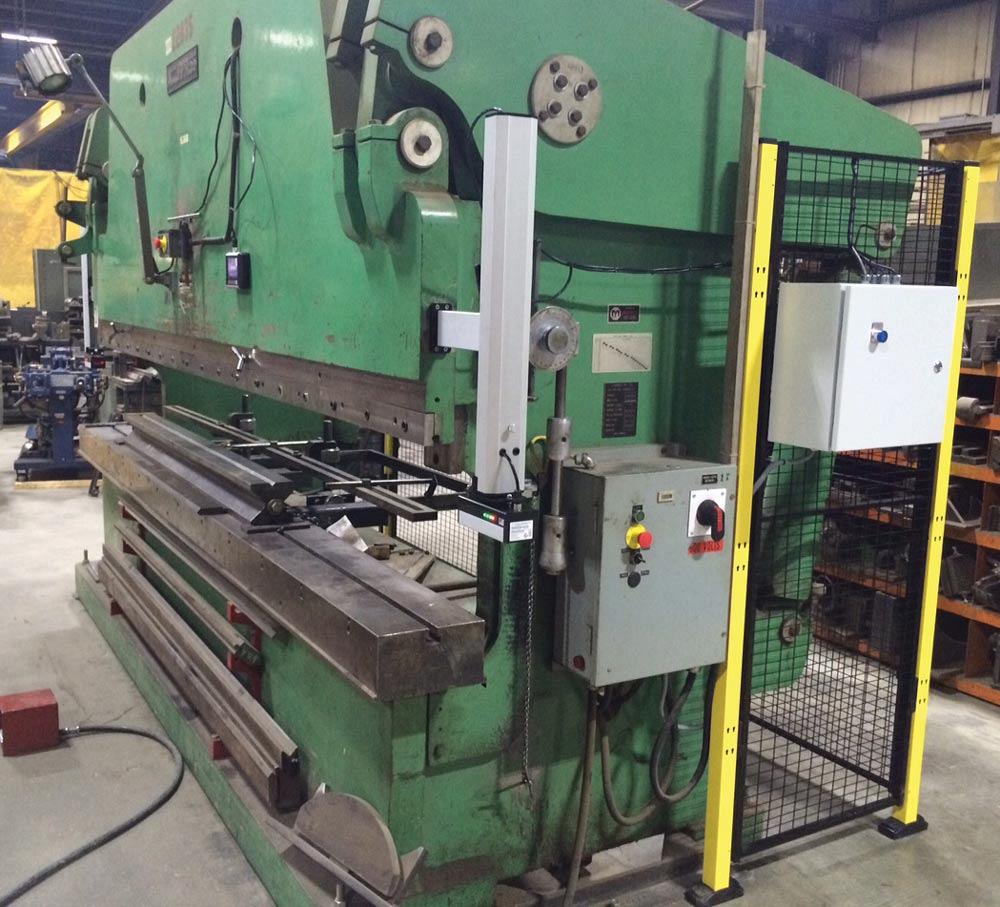
The first steps to bring an older press brake up to compliance with CSA standards include retrofitting it with interlocked rear gating, adding an active optic protective device (AOPD) to prevent injuries from crush and pinch hazards
2. Proper Safety Enhances Production
“There is a huge misconception that safety guards need to be bypassed to do a job efficiently. That’s old-school mentality. New-school is that you can keep employees safe and not have any detrimental effect on production.
“In some cases, production can actually speed up. The process can end up being streamlined with the addition of the safety system because of how the fabricating equipment and safety system work together.
“Proper safety equipment is designed to work in tandem or partnership with the operator and the machinery to maintain production levels.”
3. Customization Can Be Efficient
“There is a lot of off-the-shelf safety equipment. Some, for example saw guards, just requires installation to meet full CSA compliance. But there are cases where making the best safety choice goes beyond purchasing and installing a piece of safety equipment on one machine. And when there are several safety options for a situation, determining which one will meet the company’s needs at the most appropriate price requires familiarity with the safety codes and the available safety equipment options.
“For example, a large manufacturer was concerned about guarding people in the shop in addition to the machine operators. Developing the safety system required finding out what machines were on the floor, what type of components they produced, and the location of the other people. Based on that information, equipment like area scanners, pressure mats, and wire fencing were combined into a system to keep people from entering a critical zone where injuries could happen. Even the operator had to be out of the zone for the machine to operate.
“Another example is when a company buys a standard light curtain, transmitter, receiver, and safety relay online. That type of system can be relatively cheap to purchase and install, but it does only one thing: it shuts the machine down when the beam is broken to keep objects out of a given area. But what if the dimensions of the workpiece extend into the area restricted by the beam? A custom safety option that protected the operator’s hands but ignored interference caused by the part was implemented. A programmable light curtain--with flowing blanking, properly selected resolution, and mounted at the correct safety distance--allowed a certain number of beams to be muted. As an example, three or four beams can be blocked out and allow machine functions to continue, but if the fifth beam is broken, the machine shuts down.
“Customized safety equipment doesn’t mean installing the highest-priced system. Each project is considered from a dollars-and-cents perspective, and there is usually more than one safety system choice. I’ve found that 97 per cent of the time my customers choose a system that costs a little more and provides better protection.”
4. Changing Codes Need Monitoring
“Safety standards change, and it’s important to keep up with current codes. Years ago, for example, a portion of the codes called for restricting third-party access to a machine. That was a broad statement, and the response might have been putting a chain up behind the equipment. Technically it restricted, but didn’t stop, access. People could step over or disconnect the chain, and the equipment would still be running.
“The code has been modified in that aspect alone. Now it says that if third-party individuals go behind a piece of guarded equipment, that piece of equipment needs to be deactivated, or the motion control deactivated, or shut completely down prior to entrance in the danger area.
“Learn about the codes before an inspector does a walk-through to find what is not in compliance. Safety integrators can come in and help educate. Another good place to get information and ask questions is at tradeshows.”

Custom electrical cabinets often are designed to organize and house safeguarding electrical components and locate the machine’s safety equipment.
5. Proper Training Is Critical
“Regular, professional safety training for all employees is a big step in creating a safe facility. Make sure every employee has proper safety training on any piece of equipment he may be asked to operate.
“If an operator who has used a machine for a number of years is required to train the new operator, there is a good chance the new person will retain only about 60 to 70 per cent of the information shared. Then operator No. 2 trains another new employee who retains only 60 to 70 per cent of the original 60 to 70 per cent. The safety and machine operating information continually gets watered down. An operator may end up lacking some information that can lead to harm and will, in turn, hurt the company.
“Hire a trainer to come in and make sure operators get the information they need to do the job properly and safely. A half-day of professional training versus the hand-me-down training will go a long way in protecting employees and the bottom line.”
6. Safety Reminders Should Be in View
“Many manufacturers prominently display their safety records, counting up the days without a lost-time incident. This accomplishes several things for employees. It serves as a visual reminder that safety is important to the company and helps keep safety at top of mind on the shop floor. And it reminds the company, on a daily basis, of how effective its safety program is.“When a company’s safety number goes up each time I visit, it tells me that something is right. Either its people are paying attention to safety or a good amount of safety actions are being taken within the facility, or both.”
Photos courtesy of Wallace Machinery & Tool Co. Ltd., 204-788-1199, www.wallacemachinery.com
About the Author

Sue Roberts
2135 Point Blvd
Elgin, IL 60123
815-227-8241
Sue Roberts, associate editor, contributes to both Canadian Metalworking and Canadian Fabricating & Welding. A metalworking industry veteran, she has contributed to marketing communications efforts and written B2B articles for the metal forming and fabricating, agriculture, food, financial, and regional tourism industries.
Roberts is a Northern Illinois University journalism graduate.
subscribe now


Keep up to date with the latest news, events, and technology for all things metal from our pair of monthly magazines written specifically for Canadian manufacturers!
Start Your Free Subscription- Trending Articles
Class is in session for college connections
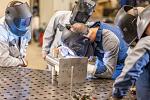
Engine-driven welding machines include integrated air compressors

Compact 2D laser machine designed for smaller shops
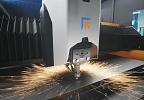
Push-feeding saw station cuts nonferrous metals

BlueForge Alliance partners with Nuts, Bolts & Thingamajigs to develop Submarine Manufacturing Camps

- Industry Events
ZEISS Quality Innovation Days 2024
- April 15 - 19, 2024
Tube 2024
- April 15 - 19, 2024
- Düsseldorf, Germany
Lincoln Electric's Large Format 3D Metal Printing Seminar
- April 16 - 17, 2024
- Cleveland, OH
CTMA Economic Uncertainty: Helping You Navigate Windsor Seminar
- April 30, 2024
- Windsor, ON Canada
MME Winnipeg
- April 30, 2024
- Winnipeg, ON Canada











